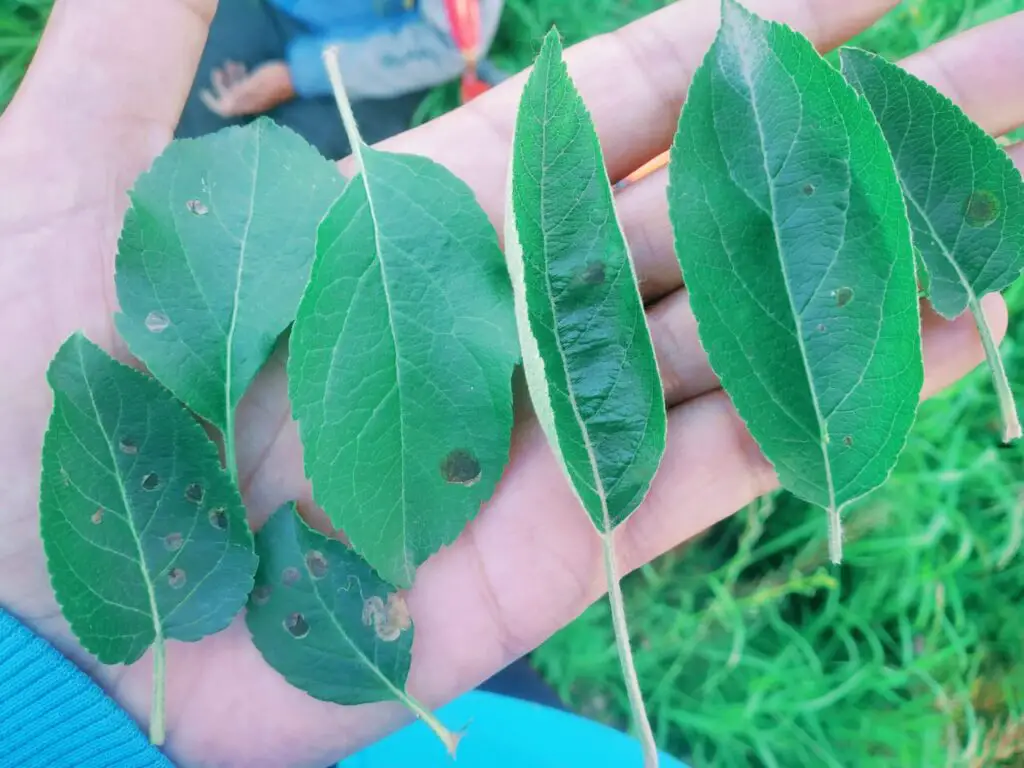Introduction
Apples are the backbone of the economy in the Kashmir Valley, being one of its key horticultural crops. The region is famous for its temperate climate, which makes it ideal for producing the juicy, crispy, and vibrant colored apples it is renowned for. However, this thriving crop has been under threat in recent years, as it is under attack from a seemingly innocuous yet deceptively destructive pest: the leaf miner.

What is a leaf miner?
The leaf miner is a tiny, inconspicuous insect that belongs to the Lepidopteron family. There are many species of leaf miners, but one in particular, the apple leaf miner (Phyllonorycter blancardella), causes severe damage to apple orchards. The larvae of these moths feed on the leaf tissue, effectively tunneling between the top and bottom layers of the leaf, creating visible mines. This not only affects the aesthetics of the tree but may lead to a significant reduction in fruit yield, as it disrupts the essential process of photosynthesis.
The leaf miner issue in Kashmir’s apple orchards
Over the years, leaf miners have become widespread in Kashmir, resulting in a decrease in apple productivity. The insects have a preference for apple varieties such as Delicious, Golden Delicious, and American Trel, all of which have significant commercial value. As the leaf miner infestations continue to proliferate, Kashmiri apple producers are becoming increasingly concerned about their livelihoods.
Environmental factors contributing to the problem
A combination of environmental and human factors has contributed to the prevalence of leaf miners in Kashmir’s apple orchards. The mild temperature of the region provides a conducive environment for the growth and reproduction of the pests. Additionally, the misuse and excessive application of chemical pesticides by farmers have had devastating effects on the population of natural predators that would typically keep the leaf miners in check.
Combating the leaf miner menace
To save the apple industry and protect the livelihoods of farmers in Kashmir, it is crucial to adopt effective, sustainable strategies to eliminate the leaf miner threat.
- Integrated Pest Management (IPM): This approach involves using multiple pest management techniques, such as biological control, chemical control cultural practices, and insect monitoring. This helps to minimize the use of chemicals and increase the efficiency of pest control while being environmentally friendly.
- Biological control: One of the most promising methods to control leaf miners is by using natural predators such as the parasitic wasp (Diglyphus isaea), which feeds on the larvae of the leaf miners. Introducing these and other beneficial insects into the orchards can provide effective control of the pests without harming the environment.
- Monitoring and early detection: Farmers should be vigilant in monitoring their orchards for signs of leaf-miner infestations. Early detection allows for prompt intervention and greatly reduces the risk of widespread damage.
- Chemical control: The use of chemicals should always be a last resort, and only if the pest population has reached an economic threshold level. Farmers should use chemicals sparingly under the proper guidelines for the application to prevent resistance.
- Adopting cultural practices: Regular pruning of infested leaves, maintaining proper sanitation in the orchards, and using reflective mulches can help reduce leaf-miner populations.
Insecticides for leaf miner
Proven insecticides for the control of leaf miners include products containing active ingredients from different chemical groups. These insecticides are typically effective if used properly and as part of an Integrated Pest Management (IPM) strategy, which combines chemical, biological, and cultural control methods. Some proven insecticides for leaf miner control include:
- Organophosphates: Insecticides containing organophosphates, such as acephate (Orthene), malathion, and chlorpyrifos, have been proven to be effective against leaf miners. However, due to environmental concerns and potential impact on human health, some organophosphates have been phased out or are under scrutiny for continued use in many countries.
- Neonicotinoids: Imidacloprid (Admire, Confidor, Mida) and thiamethoxam (Actara, Cruiser) are examples of neonicotinoid insecticides that can control leaf miners. These systemic insecticides are applied to the soil or as a foliar spray and are taken up by the plants, providing control of leaf miners when they feed on the plant tissues. However, due to concerns about the effects of neonicotinoids on pollinators, especially bees, their use is highly regulated in several countries.
- Spinosyns: Spinosad (SpinTor, Success) and spinetoram are spinosyn-based insecticides derived from naturally occurring soil bacteria. These insecticides effectively target leaf miners while being relatively safe for beneficial insects, which makes them a good option for IPM programs.
- Pyrethroids: Lambda-cyhalothrin (Karate, Warrior) and permethrin are examples of pyrethroid insecticides effective against leaf miners. Although these insecticides generally have fast knockdown effects, they may not provide long-lasting control and can be toxic to a wide range of beneficial insects, making them less suitable for IPM programs.
- Insect Growth Regulators (IGRs): Insecticides like methoxyfenozide (Intrepid) and diflubenzuron (Dimilin) are examples of IGRs. They interfere with the development and molting of leaf miner larvae, preventing them from reaching maturity and reproducing. IGRs are considered more environmentally friendly and have less impact on beneficial insects.
- Biological insecticides: Products containing Bacillus thuringiensis (Bt) like Dipel, XenTari, or Biobit are effective against leaf miner larvae when ingested. These microbial insecticides are safe for humans, pets, and beneficial insects, making them an ideal choice for IPM programs.
Always read and follow label directions when using insecticides and consult local regulations before applying any chemical controls. Furthermore, proper monitoring and early detection of leaf miner infestations, along with the rotation of insecticides with different modes of action, can help to reduce the risk of developing resistance in leaf miner populations.
Conclusion
The leaf miner poses a significant threat to the apple industry in Kashmir, which has historically been the lifeblood of the region. Farmers, researchers, and policymakers must work together to implement effective, environmentally friendly strategies to tackle this menace and preserve the livelihoods of countless Kashmiri farmers. With proper awareness, education, and management practices, it is possible to reclaim the apple orchards of Kashmir from the destructive grip of the leaf miner.



